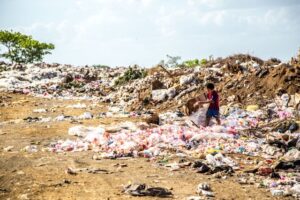Physical Address
23,24,25 & 26, 2nd Floor, Software Technology Park India, Opp: Garware Stadium,MIDC, Chikalthana, Aurangabad, Maharashtra – 431001 India
Physical Address
23,24,25 & 26, 2nd Floor, Software Technology Park India, Opp: Garware Stadium,MIDC, Chikalthana, Aurangabad, Maharashtra – 431001 India

By Vivek Saini
According to a comprehensive global study by the University of Leeds, India has emerged as the world’s largest plastic polluter. The study, published in Nature, points to the alarming scale of plastic pollution across the globe, with India ranking at the top due to its vast amounts of uncollected and improperly managed waste. This article delves into the global plastic pollution crisis and examines India’s significant contribution, highlighting the underlying causes and potential solutions.
The Global Plastic Pollution Crisis
The study conducted by the University of Leeds has revealed a global plastic pollution crisis of unmanageable proportions. In 2020, 52 million tonnes of macroplastic waste were released into the environment due to uncollected waste and open burning. This crisis is exacerbated by poor waste management systems, particularly in developing regions. Sub-Saharan Africa, for instance, is identified as a potential future hotspot due to rapidly growing populations and inadequate waste disposal infrastructure.
Researchers stress the crucial role of international cooperation in addressing this crisis. The study calls for a legally binding global treaty, informed by scientific data, to curb plastic pollution. Such measures could help mitigate the impact on human health and the environment, especially in regions where communities lack the resources to manage waste effectively. This underscores the importance of global unity in tackling environmental issues.
The Impact on Developing Nations
Developing nations, such as Nigeria and Indonesia, are disproportionately affected by plastic pollution, joining India at the top of the list of polluters. These countries face unique challenges due to weak waste management infrastructure and high population density. The study estimates that two-thirds of global plastic pollution originates from uncollected rubbish, a trend particularly pronounced in low- and middle-income countries. The environmental and health impacts of open burning of plastic waste are severe, contributing to respiratory illnesses and broader ecological degradation.
Despite the daunting challenges, the study provides a beacon of hope by offering a data-driven foundation for policymakers. By targeting the most affected areas with focused interventions, the global community can make significant strides in reducing the environmental burden of plastic waste, instilling a sense of optimism for a cleaner and more sustainable future.
India’s Contribution to the Crisis
India’s status as the world’s largest plastic polluter is attributed to the enormous volume of uncollected municipal waste and open burning at landfills. The study estimates that India emits around 9.3 million tonnes of macroplastic waste annually, enough to fill 604 replicas of the Taj Mahal. Over 90% of this waste comes from municipal sources that are either not collected or burned at disposal sites, releasing harmful environmental pollutants.
The Indian government has tried to address this issue through regulations such as the ban on single-use plastics. However, these measures have only scratched the surface of the problem. For instance, plastic bags—often targeted by these regulations—account for only a tiny fraction of the overall waste. The more significant issue lies in the ineffective waste management systems, particularly in rural areas where waste collection and proper disposal are minimal.
Challenges and Potential Solutions in India
One of India’s most significant challenges is urban and rural waste management disparity. While urban centres often have better collection systems, rural areas are primarily neglected, leading to widespread dumping and open burning. The Central Pollution Control Board (CPCB) has reported that sanitary landfills are vastly outnumbered by uncontrolled dumpsites, further exacerbating the problem.
Experts suggest India improve waste segregation at the source and enhance waste collection coverage, especially in rural areas, to combat this issue. Investing in sustainable waste management infrastructure and promoting circular economy practices could also help reduce the country’s plastic pollution footprint. These measures and strict regulation enforcement could pave the way for a cleaner and more sustainable future.
References:
https://www.nature.com/articles/s41586-024-07758-6
https://phys.org/news/2024-09-uncollected-major-sources-plastic-pollution.html
Photo by Muhammad Numan on Unsplash
Banner image:
Photo by Hermes Rivera on Unsplash